
Atomic Habits Summary
Micro summary
Start with small habits. They will compound over time to give you remarkable results. To stick with your habits you need to make them obvious, easy, enjoyable, and rewarding. To go beyond habits to mastery, add deliberate practice and reflection.
Note: Some of the examples are added by the summary writer*
Compounding

Small changes don’t seem to have noticeable effects. We can’t see the results now, so we dismiss them. However, over a long period of time, they grow exponentially. Just like investing, the tiny results of your habits will compound over time. 1% improvements will transform you into a much better version of yourself. 1% errors will make you much worse.
There’s a breaking point when the compound of tiny effects becomes at least decent enough. You need to be patient and stick long enough to see it.
Focus on building systems instead of setting goals

Setting goals won’t get you success. Losers had their goals set too. You win when you build a great system. Goal: Reading 52 books this year (one book/week) System: Preparing the list, reading everyday, updating your list with books you like more, writing what you learn, trying audiobooks while reading.
Once you focus on the system, goals will take care of themselves.
You can reach a goal when you feel (momentarily) motivated. A certain goal like cleaning your room can be done with a surge of motivation. But that doesn’t mean you fixed the problem. You just fixed the outcome which is the surface of the problem.
A system, however, will help you fix the causes and the consequences. You can reach your monthly revenue goal by a lot of hustle and grind. But that’s temporary. That won’t fix the problem of lack of customers, low profit margin, low quality product, etc. Your system includes establishing an executing a marketing plan, talking to your customers, improving product quality, improving customer support, etc. You take care of the system. And the system will take care of your goals.
Chasing goals will defer the feeling of fullfillness. You think that once you each a goal, you’ll be happy. So you defer happiness until that point in time. Instead, enjoy the process. You’ll find much more fullfilment in the journey than you’ll ever find when reaching a goal.
Once you reach a goal, then what? When your process is focused on goals, it’s easy to go off the rails. When you have a system, however, you’ll be on the right path to the next goal without chasing the thrill of reaching it.
Commit. Embrace systems. Trust the process. Progress will come. Goals will be achieved.
The duality of habits and identity:

Your identity affects your habits
There are three layers of behavior change:
- Identity: Being a writer, an athlete, a musician.
- Process: Writing routine, running program, violin practice.
- Outcome: Publish a book, win a race, get an award.
Identity is the deepest layer. You need to alter your self-image so you can act like the person you want to be. If you think you think you’re a smoker anymore, you’re more likely to quit.
2. You are your habits
Your habits determine who you are.
You do something. That something feeds a certain identity.
You write. You feed your identity as a writer.
You stick with doing something. You feed your identity as a disciplined person.
You workout. You feed your identity as an athlete.
Habits are the evidence that you are who you claim.
The most effective way to build habits is to understand who you want to become. If you have a goal in mind. Ask yourself: What kind of person can achieve a goal like that? Aim to be that person by doing what that person is supposed to do.
Your habits are the system to becoming the person you want to be.
Habit Design

To understand how we can design a habit, we need to understand how they get formed. Our brains build habits to save energy. The more we repeat something, the more it becomes so easy that we can do it on autopilot. This is how we optimize for efficiency.
Habits are systems we build for recurring problems. Running can help you calm your anxiety. Anxiety is a repetitive problem. Running is the system to solve it.
Once we discover that a certain solution works for a recurring problem, we repeat it. We no longer need to think about a solution because we already tried one that worked.
It goes like this Cue: We feel stressed out Craving: We want to relieve it and feel calm Response: We go for a run Reward: Stress levels go down and we feel good. This is the habit loop.
Now that we understand how a habit gets formed. We can design and optimize each step of the process.
Cue level: Make it obvious
Craving level: Make it attractive
Response level: Make it easy
Reward level: Make it satisfying
First law: Make it obvious
Be aware of your habits Every habit starts with a cue. You see a cookie and suddenly you’re hungry. When a habit is deeply rooted in our routine, cues can become invisible. You know that, suddenly, you want to eat but you don’t know what triggered that craving. But you need to be aware of that. That’s because building new habits, we need to first understand and organize our current ones.
The habits scorecard
 Write down every habit you do. Add a plus sign (+) when it’s a good one, a minus sign (-) when it’s a bad one, and an equal sign (=) when it’s neutral. This is called the habits scorecard. It’s a practical way to become aware of your habits.
Write down every habit you do. Add a plus sign (+) when it’s a good one, a minus sign (-) when it’s a bad one, and an equal sign (=) when it’s neutral. This is called the habits scorecard. It’s a practical way to become aware of your habits.
Implementation intention
![I will [do the habit] at [specific time] in [specific location]](/assets/atomic-habits/formula.png)
To do that thing you want to do, make sure you mention when and where you’re going to do it. Researchers have found people who use this method have a higher probability of doing the activity.
Here’s the template: I will [do the habit] at [specific time] in [specific location].
For example: I will practice yoga for 20 minutes in the living room at 5 pm.
This method is called implementation intention.
Implementation intention can also be used successfully by using habit stacking instead of using a time and a place.
Habit stacking
![After [old habit], I will do [new habit]](/assets/atomic-habits/stacking.png)
Stack a new habit to an old one you already do. Here’s the template: After [old habit], I will do [new habit] For example: After breakfast, I will meditate for 5 minutes. The old habit becomes the cue to the new habit.
Alter your environment
Make the cues to the desirable habits so visible that you can’t miss. If you want to read more, put a book in a visible place in the living room.
Design the context
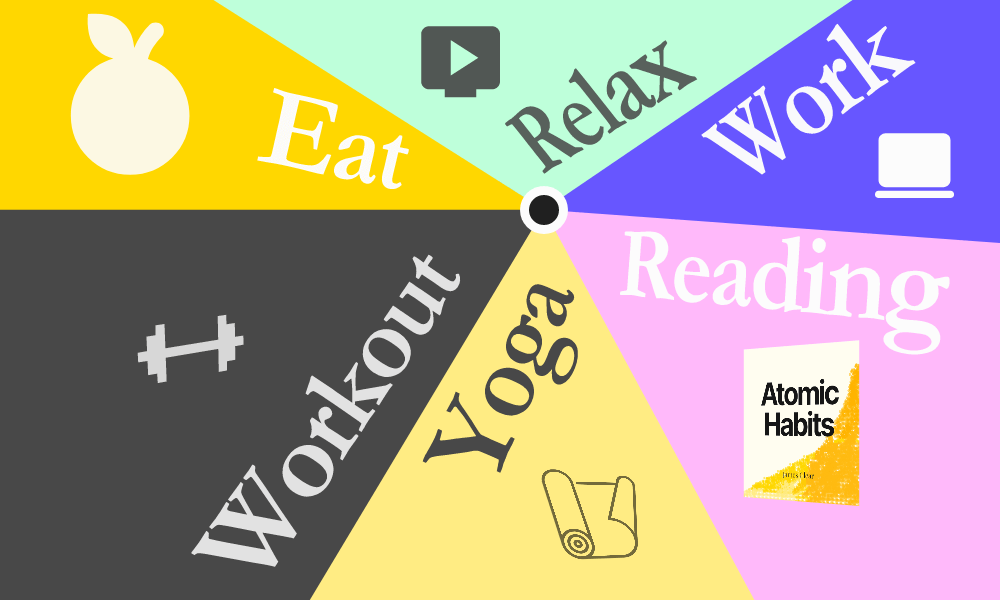
Our brain associates a certain context with an activity. If you use your bedroom to work, play video games, and sleep, It’s hard to link a certain activity with the bedroom. If you want to create a new habit, you need a place where there are no other cues from other habits. This way you’ll be much less distracted and drawn to to other habits. If you want to build a stronger habit of reading, you’d have a much bigger probability to succeed if you do it in a new context.
Divide your house by context. Have room for each big habit. If you don’t have the luxury to do that, you can divide one room into different contexts: A desk for work, a chair for reading, a table for eating, etc.
One activity. One context. One cue. Or at least, very few cues.
Hiding a cue beats self-control
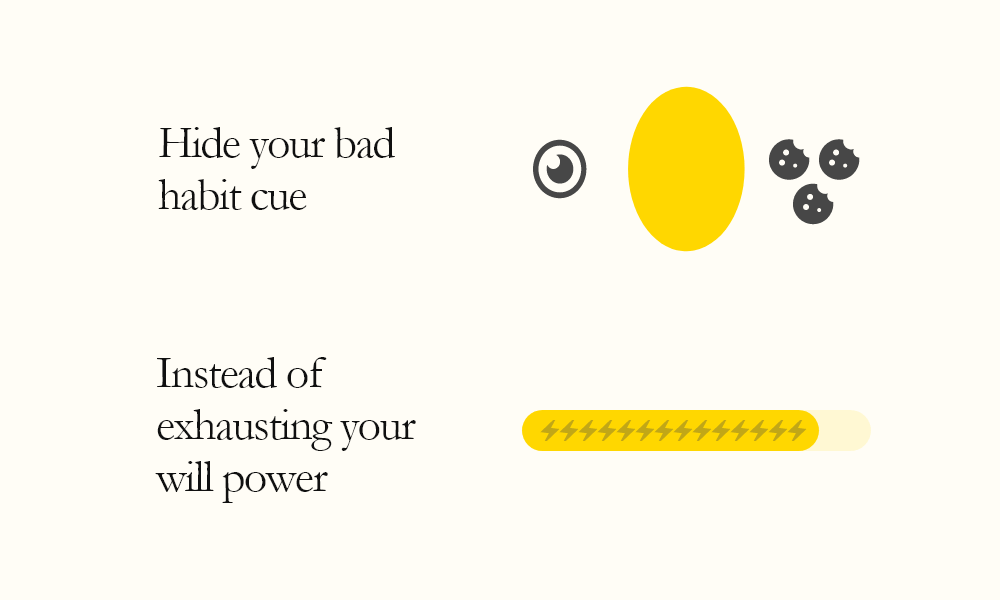
Self-control can work in the short term. You can gather some willpower to stop doing something, but you’re less likely to succeed by that alone. In fact, you’re more likely to control yourself if you don’t actually get tempted.
Because each habit starts with a cue, you can eliminate your bad habits by hiding their cues. If you’re constantly wasting time on your phone, try leaving it in another room while you get your work done.
Second law: Make it attractive
Dopamine gets released when we anticipate a reward. We feel more pleasure when we’re anticipating the reward than when we actually get it. It’s just the way the human mind works. That’s why you need to make a new habit attractive. But how?
Temptation bundling
![After [old habit], I will do [new habit I need]. After [new habit I need], I will do [pleasurable habit]](/assets/atomic-habits/pleasure.png)
Again, you can pair an old habit with the new one. But this time, you can add a third pleasurable habit you want just after the habit you need. Here’s the template:
1. After [old habit], I will do [new habit I need]
2. After [new habit I need], I will do [pleasurable habit]
For example:
1. After breakfast, I will meditate for 10 minutes
2. After meditation, I will check Instagram
The pleasurable habit will become the reward you anticipate.
Join a tribe
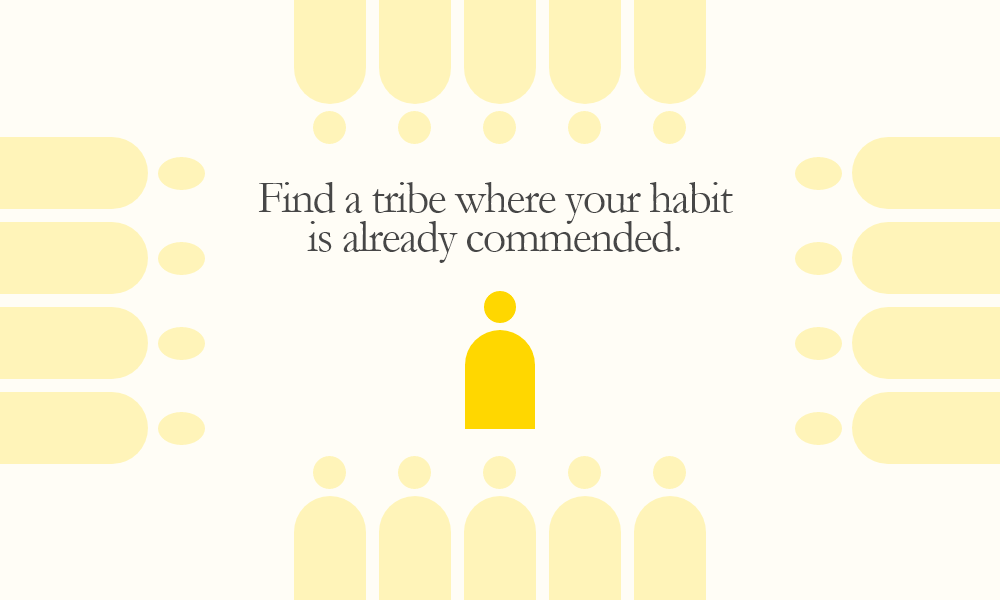
We want to be loved and praised by our close tribe, so we do what helps us get the approval of our family, friends and colleagues. We want to feel that we belong so we do the things that people like us do. We want to get higher in the hierarchy so we imitate people with high status.
Attractive habits are the ones that can help us get the approval, respect, and praise of our family, friends, peers, and tribe. Another great way to make a habit attractive is to find a tribe where doing that thing is already commended.
Join a book club, a yoga club, an MMA gym, a marketing forum, a community of writers, etc.
The charm of bad habits and its origin:
Habits are solutions to ancient recurring problems that help us go after ancient desires such as status, reproduction and belonging. But just because a habit solves a problem, it doesn’t mean it’s the best solution. The strength of the habit comes from the association we create between the problem and the feeling we predict we’ll get. But predictions vary from one person to another for the same habit. One person smokes because he’s predicting stress relief. Another one predicts a repulsive smell. Understanding that can help you shift your behavior.
Mindset shift & hard habits
We think of the hard habits we need as a drag. It’s something we have to do. How about we see it as something we get to do? An opportunity. The workout becomes a way to build strength. Not a physical pain. Reading becomes a way to have a higher understanding of the world. Not an energy-consuming mental challenge.
Third Law: Make it easy
Strategize less, act more

Strategizing is good. It helps plan for the road ahead. But it doesn’t produce an outcome. Only thinking about doing the thing won’t get you anywhere. You become stuck. Strategy becomes procrastination. It becomes a way to avoid failure by delaying it. It’s action that will move you forward. Repeating that action will help you build a habit. But how much time does it need for an action to become a habit? You’re asking the wrong question. It’s repetition that helps you build a habit, not the number of days you’ve been doing it. Writing twice a day isn’t the same as writing once a day which isn’t the same as writing once a week. Repetition is what creates habits.
Less energy
When making decisions, we optimize for saving energy. We do the easier options. That doesn’t mean we’re lazy. At least, not all the time. We surely do hard things too. But if you’re trying to build a habit, it’s important to make that action easy. When it’s easy, you’re more likely to stick with it. In the long run, these easy actions will compound to have a great effect on your life.
Less friction
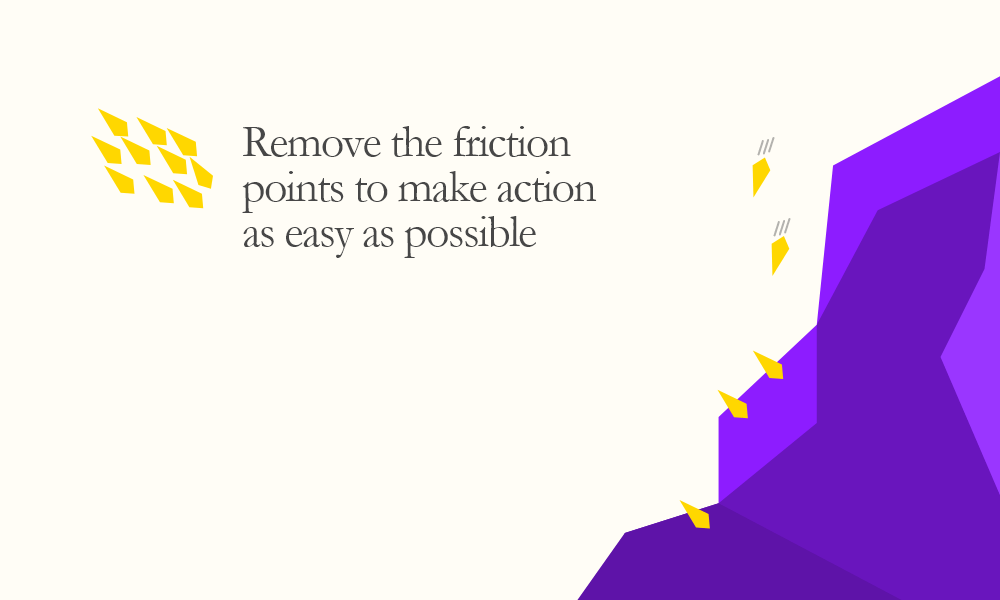
Remove all the things that make an action harder for you. If you’re starting your fitness journey, try going to a gym that’s on your path from work. Try finding all the friction points and remove them so you can make it as easy as possible to do that action.
You can also get rid of bad habits too by increasing the friction.
Prime your environment

Prepare your environment in a way that helps you:
- Start doing a desirable habit easily
- Make it hard to start doing an undesirable habit
Do you want to eat healthy? Pack healthy meals for the next week. Do you want to watch less TV? Unplug it and remove the remote batteries after each use.
The first tiny action

What’s the first tiny action you do when you work out, meditate, read, study, etc? Focus on starting by doing only that. It could be pulling out the yoga mat, changing your shoes, or reading one page of a book. You’re more likely to do the habit if you trigger that starting 2-minute action. Sometimes, your habit can be constituted by that easy action itself. You can start by reading one page every day. Eventually, you’ll start making progress by reading more each day. The goal of this ritual is to practice showing up. Once you show up consistently, you’ll start improving. Start with a tiny action and then improve it. You can’t improve a habit that doesn’t exist. You can, however, improve a tiny habit.
Commitment devices
A commitment device is an action you take to protect and enforce your habit. It’s the social media blocker. It’s paying in advance for a yoga session. It’s also Nir Eyal’s outlet timer that cuts off the internet at 10 p.m so everyone goes to sleep. It’s a task that helps you protect your habit from distractions or inertia. What commitment device makes sense for you?
One-time actions & automations
There are things we can do at one-time that can have a big effect on our lives. It’s the blackout curtain that helps us sleep better or the deletion of Facebook that helps us get distracted way less. What’s an action you can do one time that affects the area you want to improve? How can you automate that area to make it easy to stick to your habits and avoid the bad ones? Maybe start an automatic saving plan.
Fourth Law: Make it Satisfying
Instant and delayed gratification
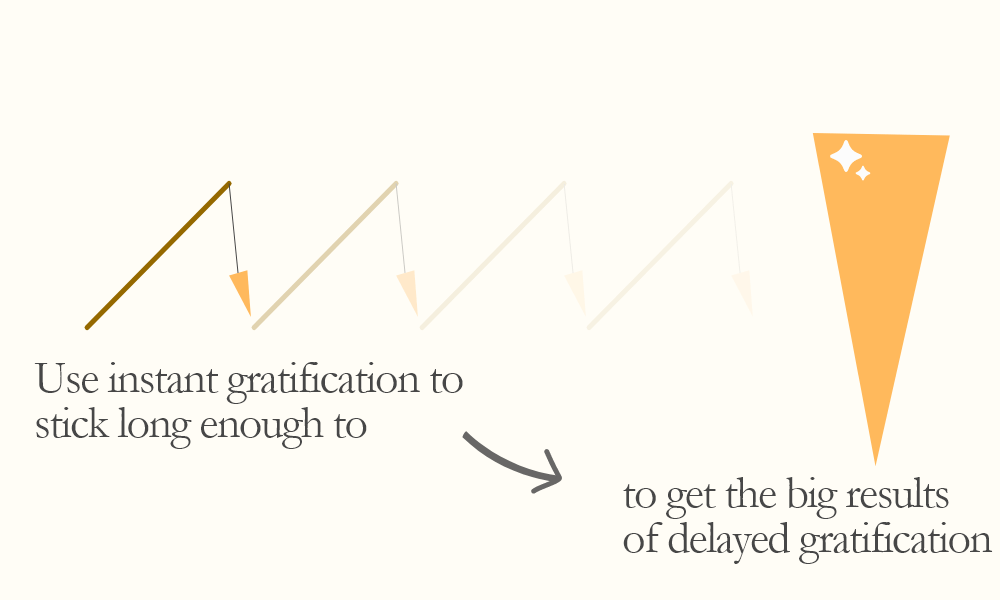
We strive for rewards. So we do what rewards us. We run away from punishment. So we avoid doing what punishes us. Rationally, we want to build habits because we want the long-term gains. That’s the power of delayed gratification. But, from an evolutionary perspective, our brain works differently. We tend to do the things that can get us instant rewards. Our brain is strongly driven by instant gratification. So, we need to make sure the actions we want to do are satisfying in the short term. This way, we can stick to our habits in the long run. The results will then compound and the habit becomes automatic. Try rewarding yourself every time you do a good habit or avoid doing a bad habit.
Habit tracking

Tracking habits can help us visualize what we do. It shows us our progress at a glance. It helps you keep going because you wouldn’t want to break the streak. It keeps you focused on the system, the journey, and the process rather than the goals. It’s also pleasurable to put that X celebrating getting something done. It offers an intrinsic reward.
Recover
Your habit can get interrupted. Maybe an emergency happened. Don’t quit. Just make sure you never miss twice in a row. This way, your habit won’t get affected.
To track or not to track
Sometimes we’re measuring the wrong thing. If you didn’t lose weight but felt better sleep quality, that’s progress. Sometimes we get driven by chasing the number we’re tracking and we lose sight of why we’re tracking in the first place.
We track because it helps stay consistent and committed. But we don’t track for the sake of tracking. Keeping your language learning streak is good. That’s because every day you’ll learn more. But, don’t get more obsessed by that streak number than by learning itself. Don’t let it become more important than the habit itself.
Punishment
To avoid a bad habit, you need to punish yourself once you do it. The punishment should be immediate.
You can also tie a punishment with failing to do a desired habit. For example, Thomas Frank has an automatic tweet saying that he’s lazy if he fails to wake up before 6:10 a.m.
Another less extreme way is to find an accountability partner. You can play as her accountability partner too. We don’t want people to think that we’re lazy, undisciplined, or unreliable. That’s the intrinsic punishment.
Beyond habits
Genes
Your genes affect your success in a certain area. Certain features of your body can help you become a world-class swimmer like Michael Phelps but keep you from becoming a world-class runner like Hicham El Guerrouj. Your personality can vary genetically based on four traits: conscientiousness, agreeableness, neuroticism, openness, and extraversion. Pick a game that favors your personality or your physical abilities. Or both.
Play a game you can win
Building habits is a long-term game. If the habit is not for you, or if it’s too hard, you’re more likely to quit. Find something you like. Something that you can’t feel time passing while doing it.
The strengths and weaknesses encoded in our genes have a big effect. But they don’t replace the sweat and tears we need to put on. What they offer is a direction to easier (but not necessarily easy) possibilities where we’re more likely to succeed.
Embrace boredom
When you’re immersed in doing something, you just enter the flow state. Reaching this enjoyable productive state requires us to work barely above our abilities. Doing the same thing over and over again can be boring. But to win, you need to embrace the boredom. You need to show up again and again. My favorite quote from the book is the following: “Professionals stick to the schedule; amateurs let life get in the way”
Adding deliberate practice
The very thing that makes habits powerful, hides its biggest drawback. Repetition is what makes an action a habit. But once you repeat an activity for a long time, it becomes automatic. In fact, the quality produced gets slightly worse each time. We need to avoid that. We also need to make sure you keep getting better even after reaching the habit zone. The solution is deliberate practice. You need to introduce some new challenges and try slightly new things.
Reflection
Every now and then, stop to reflect on your progress and performance. This will help you get out of the automatic cycle to see what areas should you improve. Make that process of reflection repeatable.